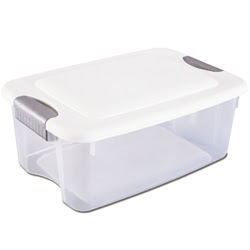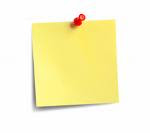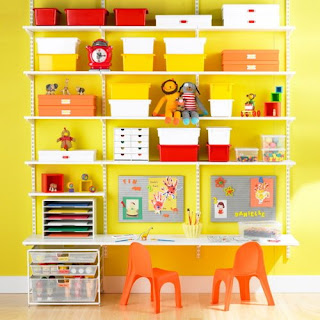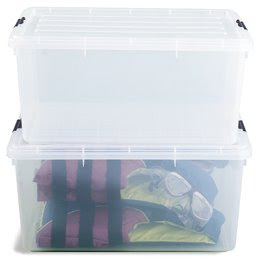
The most important thing to think of is the layout of the room. This is so vital because dorm rooms are so teeny tiny that you must make the most out of your space to take advantage of the organizational potential. In my dorm room we were able to loft our beds. Under my bed went the futon and the comfy chair with storage ottoman and under my roommate's bed was the refrigerator, microwave and our food storage area plus one of our sets of stackable drawers. We wouldn't have been able to successfully have all of the things in our dorm room if we weren't able to loft the beds.
An absolute MUST in dorm life is at least one set of stackable drawers. Target and Bed Bath & Beyond have a huge selection of these (and they're probably on sale right now!). My dorm room had two sets in different sizes. One of the sets of drawers in my room was bright orange, which added a nice flare to the stark and dingy looking room. We stored supplies like tape, 3-M hooks, batteries, shower products and even clothes I think.

I do have to credit my roommate for pretty much all of the wonderful organizational items found in our dorm room. She brought most of them! And she is very creative so everything worked wonderfully.
My roommate brought in this great set of stacking cubes. We used these to store food in. These would also work well to store clothes, shoes, school supplies, books and shower products in.
The closets and the built in storage in my dorm room were actually quite substantial. Each of us had two sections of closets to store things in. Needless to say we had a lot of room to hang our clothes! I also employed a shoe tree and somehow hung it in my closet (mine is supposed to be an over-the-door shoe tree...). It worked really well, and I highly recommend if you're bringing a lot of shoes to college to use a shoe tree or some kind of shoe organizer.

One thing that I didn't think about at the time of my freshman year was over-the-door hooks. My roommate came prepared and brought two different sets. We used one on the back of our dorm door and the other was hanging from her bed (remember it was lofted). These were so amazingly handy to have! We used them to hang our backpacks, jackets, sweaters and big winter coats and scarves (we went to school in Iowa) from.
Under-the-bed storage is wonderful, especially in a dorm room. Since our beds were both lofted and hanging from the ceiling we couldn't really store things under our bed (well I suppose we could have...) but we did have a futon on the ground that we used to store things under. We used clear plastic containers to store little odds & ends in and then housed them under the futon.

If you need more tricks for dorm room organization, look to the upper classmen. I did take a lot of my current knowledge from their advice and experience as freshmen living in the dorms.
When it comes to dorm room organization, the name of the game is creative. You must be creative because you're working in such a small space, usually with limited resources and you're combining two people's things in to a tiny space big enough for a mouse to live in.
Read More!






































